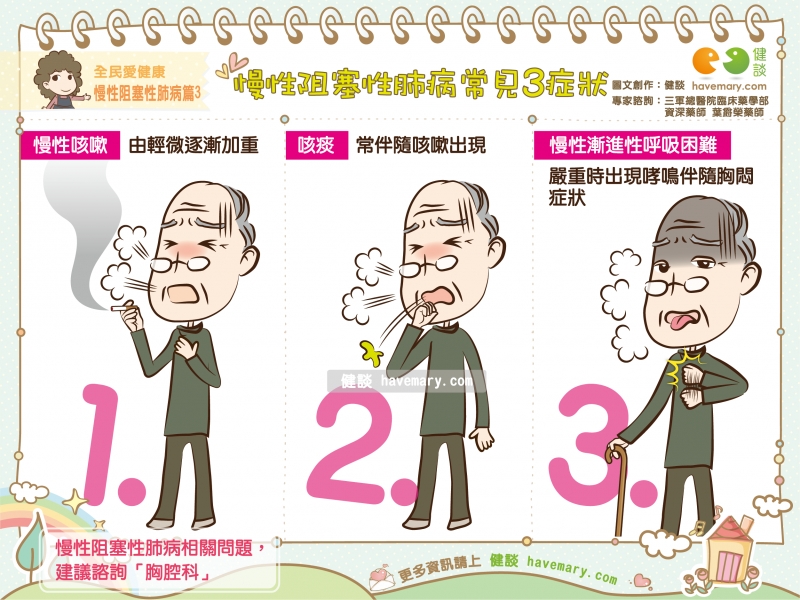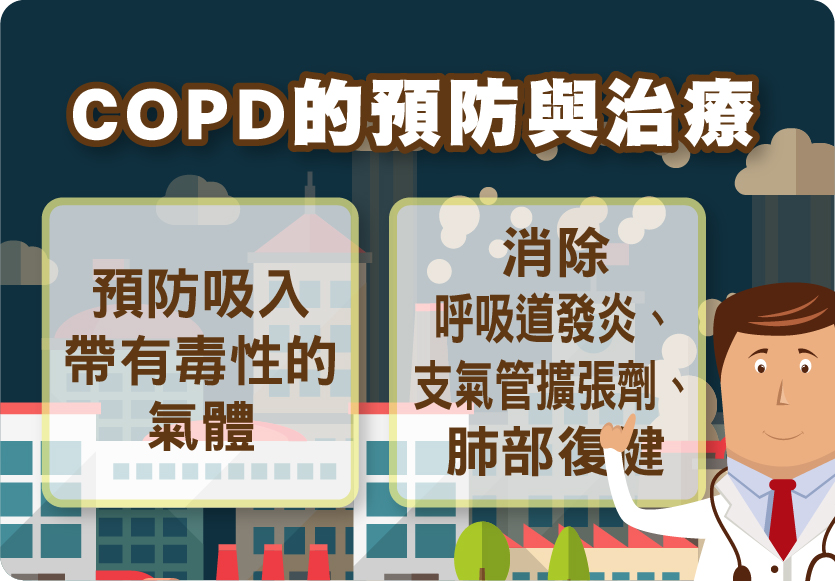Youtube video explaining COPD symptoms, causes and traditional treatments

Symptoms of chronic obstructive pulmonary disease usually appear after significant lung damage has developed, and they often worsen over time, especially if exposure to smoking continues. COPD is often misdiagnosed, and ex-smokers may sometimes be told they have COPD when in fact they may have a simple disorder or another, less common lung disease. Likewise, many people with COPD may not be diagnosed until the disease is advanced and interventions are less effective. Symptoms of COPD include:
- shortness of breath during daily activities or physical activity
- chronic cough
- respite
- tightness in the chest
- frequent respiratory infections
- bluish lips or nail beds
- malaise and low energy or chronic fatigue syndrome
- Producing a lot of mucus or phlegm Having to clear the throat first thing in the morning due to excess mucus in the lungs
- Unexpected weight loss (late stage)
If you frequently experience one or more of the above symptoms, you definitely need to seek medical advice. Diagnosis Multiple tests include: lung (lung) function tests, chest X-rays, CT scans, spirometry, arterial blood gas analysis, laboratory tests COPD has four stages:
Stage 1 – very mild COPD
Stage 2 – Moderate COPD
Stage 3 – severe emphysema/chronic bronchitis
Stage 4 – very severe COPD
Each of these stages affects each patient differently, but in general, the higher the stage of COPD, the shorter the life expectancy. In developed countries, the main cause of COPD is smoking. In developing countries, chronic obstructive pulmonary disease usually occurs in poorly ventilated houses, with smoke from people burning fuel for cooking and heating. Underlying causes and risk factors for COPD include: smoking, tobacco smoke exposure, smoking asthmatics, occupational exposure to chemicals and dust, genetics (approximately 1% of childhood COPD patients). Traditional treatments include:
- quit smoking
- Medications – bronchodilators, inhaled steroids, combination inhalers, oral steroids, phosphodiesterase 4 inhibitors, theophylline, antibiotics,
- Pulmonary Therapy – Oxygen therapy, pulmonary rehabilitation programs that often combine education, exercise training, nutritional advice and counseling.
- Surgery includes – Lung volume reduction surgery, Lung transplant, Bullectomy.
Watch the following youtube video explaining the symptoms, causes and treatment of chronic obstructive pulmonary disease (COPD) in detail.
How to Treat COPD Symptoms Naturally
If you’re willing, there are many ways to treat and reduce your risk of chronic obstructive pulmonary disease with your own efforts and natural treatment. But first, you must realize you have COPD symptoms to begin with – then you can pinpoint exactly how to treat them.
- Before you use any medication or technique, The most important is to make an inner decision: “I want to regain fullness and beauty of life”, I deserve good life and a am open to all good to come in my life. When you make a decision that you sincerely want to regain your health then you are ready to start with practical steps and techniques. Then recovery will be pleasant and fast. But it is not easy at all because this decision practically means removing the root cause of your problem, so you will start with a number of smaller and easier activities enumerated below.
- The simplest is to start using Spooky 2 programs, a quantum technology that makes wanders. Then every day learn a new area, mentioned below, and start applying in your daily life, eventually, you will be a new person. You will experience your real self you will love.
- Reduce Stress & Increase Experience of Pleasure and Beauty – Find as often as possible anything that will increase your feeling of beauty, relaxation, and joy. It may be art, music, children, good food, clothing you like, massage, reading book, poetry or any other experience you enjoy. Stress is the fertile ground for all health issues and diseases, COPD too, and makes airway inflammation and shortness of breath, worse. By reducing your daily stress and managing stress in healthy ways, you’re more relaxed, and this has a direct positive effect on your COPD symptoms. You should make time every day to relax both mentally and physically. Try some of these natural stress relievers like Yoga and Transcendental Meditation.
- Avoid Smoke in Every Way –The most essential step in conventional and natural treatment plan for COPD is the same – stop any and all forms of smoking, including the electronic cigarette. You should also avoid air pollution as much as possible. If you’re not a smoker, then you definitely need to avoid places where others smoke. Smoking yourself is definitely the worst thing you can do when it comes to COPD, but secondhand smoke and air pollution can damage and irritate your lungs too.
- Improve Your Breathing –The yoga tradition has very effective berating techniques and it is worth learning it to help you breathe more efficiently with COPD. These breathing techniques can also help improve breathing for people with asthma as well as people who don’t currently have lung issues but want to optimize their breathing and energy level. The pursed-lip breathing and diaphragmatic breathing may increase your blood oxygen levels and help reduce shortness of breath. A respiratory therapist can be very helpful if you need assistance with breathing techniques.
- Follow a Healthy Diet –A healthy organic (food without herbicides, pesticides, preservatives, stabilizers, artificial colors and tastes) can help manage and improve COPD symptoms. Your diet should definitely have plenty of fresh vegetables and fruits to ensure you’re getting lots of vitamins, minerals and fiber. Citrus fruits are especially helpful because they contain quercetin. Wild-caught fish, flaxseeds and chia seeds, along with other omega-3 foods, can provide anti-inflammatory omega-3 fatty acids. Also you definitely want to steer clear of conventional dairy since pasteurized dairy is mucus-producing and can plug the airways in the lungs. You always want to stay away from processed, canned and frozen foods and sugar as well. Additives, preservatives and food dyes are also known for contributing to breathing issues and even asthma attacks.
- Exercise –When you’re having trouble breathing, exercise might seem like a terrible idea, but being sedentary won’t do anything to help your COPD symptoms. By regularly getting exercise, especially cardio workouts, you can strengthen your respiratory muscles and improve your overall endurance. About 40 percent of people with COPD experience high levels of depression and anxiety, which makes it even more difficult to quit smoking and comply with treatment. Exercise also increases endorphin levels, which improves mood, reduces depression and anxiety, and makes it easier to quit smoking. Increase Water Intake – One of the common and frustrating COPD symptoms is having mucus collect in your airways. This mucus can be difficult to clear and result in persistent and uncontrollable coughing. You can improve this mucus problem is by drinking plenty of water throughout the day. Drink at least eight glasses of water daily to thin mucus and stay hydrated. You can increase the moisture content of the air in your home by using a humidifier. Humidifiers can also help make breathing easier.
- Eucalyptus Oil– can be very helpful for people with COPD. A study in Respiratory Research showed that cineole, the main constituent of eucalyptus essential oil, actually reduced cough attacks in people with COPD. It also reduces shortness of breath and improves lung function as well as health status overall. The best is to use eucalyptus oil in a diffuser and/or humidifier and breath in the anti-inflammatory air. (Eucalyptus oil isn’t suitable for young children. It is too strong.)
- Consume Ginseng– Ginseng improves lung function and also decrease bacteria in the lungs. Panax ginseng, in particular, has a long history of use in Chinese medicine for respiratory conditions, including asthma and COPD. A study published in the journal Complementary Therapies in Medicine provides info on therapeutic ginseng benefits. Panax ginseng and ginsenosides (active components of ginseng) appear to inhibit processes related to the development of COPD.
- Take N-Acetylcysteine (NAC)- Supplementing with NAC helps decrease the severity and frequency of asthma attacks and improves overall lung function by increasing glutathione levels and thinning bronchial mucus. Glutathione fights against oxidative stress in the respiratory tract, which can make NAC a powerful and effective natural treatment for COPD.
- Avoid Cold and Crowds – it’s important to avoid things that make you feel worse: smoke and pollution, cold air can trigger bronchospasm, put on a face mask before going out into very cold temperatures, avoid large crowds, reducer risk of being exposed to infectious germs.
- Stay Away From Chemicals – In a 2015 study looking at 167 participants diagnosed with COPD, more than 60 percent of participants reported cleaning supplies as a trigger for COPD symptoms. More than 50 percent of participants reported trouble after being exposed to perfumes, scented candles or insect spray. About 50 percent reported hairspray as a problem for their COPD. By using natural DIY household products, you can avoid chemicals and improve your COPD symptoms.


